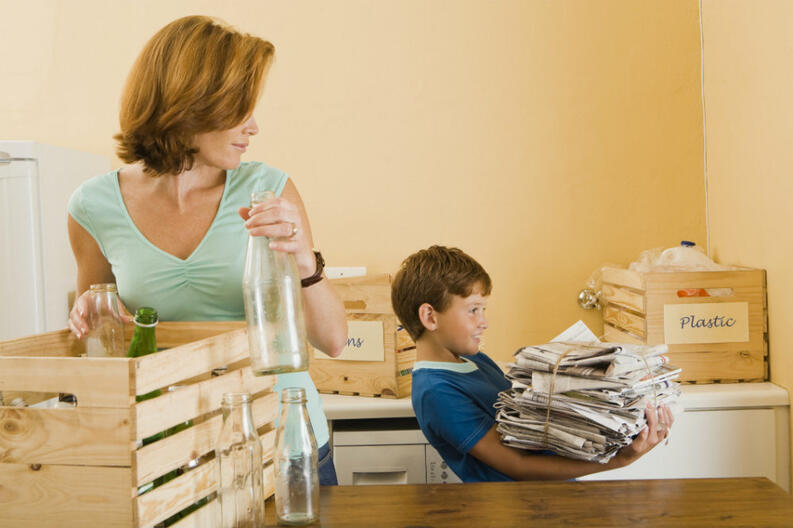When you think about all the problems caused by global warming today, it’s hard not to get discouraged. However, each of us can do something to stop contributing to this phenomenon.

Climate change is happening on such a large scale, and many of the major contributing factors seem far beyond the reach of ordinary citizens. However, your daily habits can make a significant contribution.
But is that really true? You may find it encouraging to know that there are actually things you can do to reduce global warming. Each person emits a carbon footprint, produces waste, consumes energy and buys goods. In all of these areas, you can take more sustainable action.
5 habits you can implement to reduce global warming
So, what can you do? You have many different options, but there are some daily habits that are especially easy to incorporate into your busy life.
1. Control your energy use
Many of us expend energy without conscious thought. This way you may not even realize the impact of your energy consumption. Fortunately, it is not too difficult to manage your energy consumption at reasonable levels. Here are the ways you can do it:
Read the labels of your appliances
The labels on your appliances will give you a good idea of how much energy they use. Try to choose the ones that are more sustainable than others.
Choose the right lights
We all need to use electric lights at some point. But what you should always do is make sure you pick the right ones. LED lights are great recyclable options, and they come in a wide range of colors. There are also some energy saving lamps.
Use tapas when you cook
When you cook, cover the pots or pans. This will allow food to cook more quickly thanks to the steam it traps, which saves energy. (And speaking of “cover”, make sure to close your fridge when you’re not using it too!)
Use renewable energy
In these modern times there are many renewable energy options. If you have the means to pay for an investment like this, go for it! Install solar panels and use them for power. You will save on electricity costs and at the same time reduce global warming.
Keep your house warm, but not that warm
We all like to feel comfortable and warm in the colder months. But using too much heat can add to your electricity bill and make your carbon footprint much more severe. Keep your home warm, but not warm.
Just one or two degrees less could reduce the release of carbonic acid gas by 200 kg and save up to 10% of your energy consumption.
Of course, the same goes for air conditioning. Keep your house cool, but not frosty!
2. Learn to recycle
Almost necessarily, everyone should take the time to learn to recycle. It is a crucial skill. You can probably find educational programs or classes on recycling basics in your area, and if not, there are plenty of resources to do it online. Here are some tips for recycling and reducing global warming:
Reduce
Start by reducing the number of things you use on a daily basis. Find ways to keep your consumption to a minimum.
Re-use
Try to reuse as many items as possible in your home. Slowly remove single-use items from your daily life. When you need to buy new things, try visiting second-hand markets, second-hand stores, and other similar places. Save money and save the planet at the same time!
Recycle
Try to use only items made from recyclable materials. Things made of paper, glass, plastic, and metal are fantastic options, as they can be recycled most of the time and it takes a lot less energy to make new products from them.
3. Change the way you travel to reduce global warming
Traveling is essential to get from point A to point B, but there are more positive ways to get around. Your current transportation methods are very likely to contribute significantly to global warming. This is what you can change:
Reduce your car trips
Motor vehicles produce myriad harmful emissions into the air that lead to air pollution, climate change, and exacerbation of health problems. This includes an increased risk of complications from heart disease, lung cancer, respiratory infection, stroke, COPD, and asthma.
If your car uses a combustion engine, diesel fuel, or something similar, it is best to reduce the amount of time you use it as much as possible.
Carpool
Carpooling or carpooling is a good way to continue to use common vehicles to reach further afield. It’s not exactly eco-friendly, but a single car is way better than four or five of them, especially if they all go to the same place.
Use the public transportation
Public transportation runs every day, and riding it instead of using your own vehicle can help you get to distant places quickly without your car’s emissions negatively impacting the planet.
Reduce your air travel
Air transport burns large amounts of fuel and produces large volumes of carbon dioxide. The resulting vapor trails as well as a wide range of other problems are highly damaging to the ozone layer. A single plane trip can emit a carbon footprint equivalent to a whole year of driving a car.
Walk or bike
These are great ways to get some extra exercise. In this way you and the planet will be benefiting. As long as you don’t need to travel far and are in a safe area, these are viable options.
4. Forget single-use plastics
Single-use plastic production is one of the main reasons behind the tremendous amount of waste. Here are some 2010 statistics on single-use plastics that definitely do not positively reflect the state of plastic pollution in the world. All these statistics are given annually:
- Approximately 275 million tons of plastic waste are produced globally.
- 9 million tons of plastic waste is very poorly managed, causing it to reach the oceans.
- 5 million tons of plastic waste reaches the oceans from coastal areas.
- Approximately 270 million tons of plastic are produced per year: plastics practically never degrade and do not break down.
So how can plastic waste be reduced? The best thing would be to start eliminating as much plastic as possible from your life. Of course, no one expects perfection. After all, plastic is cheap, durable, and affordable, and pretty much everything is made from it in some way.
But make an effort to gradually buy more and more sustainable products. If you have a positive thinking, you can break the daily habit of using plastics.
In the meantime, strive to eliminate single-use plastics specifically from your life. Here are some things to avoid buying or using:
- Food wrapped in plastic wrap.
- Plastic water bottles.
- Plastic bags (don’t use paper bags either – choose reusable fabric or bamboo bags!).
- Anything that has a plastic wrap or package.
5. Change the way you eat
Diet changes are difficult to make, but making them can be a great positive step on your personal journey towards a more sustainable lifestyle, as well as increasing healthy daily habits. Here are some changes you can make:
Red meat
The production of red meat, through breeding, and the cruel treatment of lambs, cows and other livestock, has especially negative effects on the environment.
It can be difficult for meat lovers to give up these foods, but with positive thinking, anything can be done. Go for protein that comes from plants (like nuts) or eat white meat!
Shop locally at farmers markets
Farmers markets are full of healthy produce produced by local farmers. Their products do not go through the harmful production processes of factory farms or large-scale production plants.
Also, buying local products means that you will not be eating products that had to be transported or shipped to you from long distances. This reduces your carbon footprint and contributes less to the emissions caused by those shipments.
Reduce your food waste
Don’t waste food. Get and cook only what you need. Instead of throwing out the leftovers, consider compost. Try not to buy food wrapped in non-recyclable plastic as much as possible.








